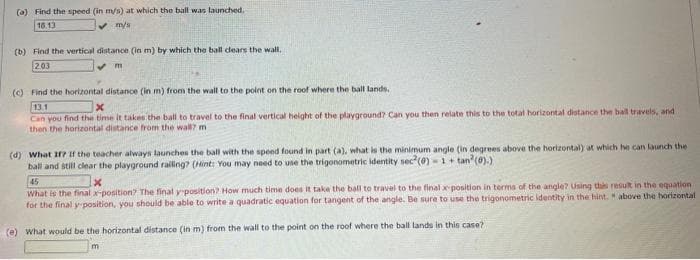Children playing in a playground on the flat roof of a city school lose their ball to the parking lot below. One of the teachers kicks the ball back up to the children as shown in the figure below. The playground is 4.60 m above the parking lot, and the school building's vertical wall is h= 6.10 m high, forming a 1.50 m high railing around the playground. The ball is launched at an angle of 0 above the horizontal at a point d= 24.0 m from the base of the building wall. The ball takes 2.20 s to reach a point vertically above the do not use rounded intermediate values in your calculations-including answers submitted in WebAssign.) 53.0 (Due to the nature of this problem, wall. mwi
Children playing in a playground on the flat roof of a city school lose their ball to the parking lot below. One of the teachers kicks the ball back up to the children as shown in the figure below. The playground is 4.60 m above the parking lot, and the school building's vertical wall is h= 6.10 m high, forming a 1.50 m high railing around the playground. The ball is launched at an angle of 0 above the horizontal at a point d= 24.0 m from the base of the building wall. The ball takes 2.20 s to reach a point vertically above the do not use rounded intermediate values in your calculations-including answers submitted in WebAssign.) 53.0 (Due to the nature of this problem, wall. mwi
Elements Of Electromagnetics
7th Edition
ISBN:9780190698614
Author:Sadiku, Matthew N. O.
Publisher:Sadiku, Matthew N. O.
ChapterMA: Math Assessment
Section: Chapter Questions
Problem 1.1MA
Related questions
Question

Transcribed Image Text:Children playing in a playground on the flat roof of a city school lose their ball to the parking lot below. One of the teachers kicks the ball back up to the children as shown in the
figure below. The playground is 4.60 m above the parking lot, and the school building's vertical wall is h= 6.10 m high, forming a 1.50 m high railing around the playground. The
ball is launched at an angle of 0 53.0 above the horizontal at a point d 24.0 m from the base of the building wall. The ball takes 2.20 s to reach a point vertically above the
wall. (Due to the nature of this problem, do not use rounded intermediate values in your calculations-including answers submitted in WebAssign.)
UN
BUNT

Transcribed Image Text:(a) Find the speed (in m/s) at which the ball was launched.
16.13
✓mys
(b) Find the vertical distance (in m) by which the ball clears the wall.
2.03
✓ m
(c) Find the horizontal distance (in m) from the wall to the point on the roof where the ball lands.
13.1
x
Can you find the time it takes the ball to travel to the final vertical height of the playground? Can you then relate this to the total horizontal distance the ball travels, and
then the horizontal distance from the wall? m
(d) What If? If the teacher always launches the ball with the speed found in part (a), what is the minimum angle (in degrees above the horizontal) at which he can launch the
ball and still clear the playground railing? (Hint: You may need to use the trigonometric identity sec²(0) - 1+ tan²(0).)
45
x
What is the final x-position? The final y position? How much time does it take the ball to travel to the final x-position in terms of the angle? Using this result in the equation
for the final y-position, you should be able to write a quadratic equation for tangent of the angle. Be sure to use the trigonometric identity in the hint." above the horizontal
(e) What would be the horizontal distance (in m) from the wall to the point on the roof where the ball lands in this case?
m
Expert Solution
This question has been solved!
Explore an expertly crafted, step-by-step solution for a thorough understanding of key concepts.
Step by step
Solved in 3 steps with 3 images

Knowledge Booster
Learn more about
Need a deep-dive on the concept behind this application? Look no further. Learn more about this topic, mechanical-engineering and related others by exploring similar questions and additional content below.Recommended textbooks for you

Elements Of Electromagnetics
Mechanical Engineering
ISBN:
9780190698614
Author:
Sadiku, Matthew N. O.
Publisher:
Oxford University Press

Mechanics of Materials (10th Edition)
Mechanical Engineering
ISBN:
9780134319650
Author:
Russell C. Hibbeler
Publisher:
PEARSON

Thermodynamics: An Engineering Approach
Mechanical Engineering
ISBN:
9781259822674
Author:
Yunus A. Cengel Dr., Michael A. Boles
Publisher:
McGraw-Hill Education

Elements Of Electromagnetics
Mechanical Engineering
ISBN:
9780190698614
Author:
Sadiku, Matthew N. O.
Publisher:
Oxford University Press

Mechanics of Materials (10th Edition)
Mechanical Engineering
ISBN:
9780134319650
Author:
Russell C. Hibbeler
Publisher:
PEARSON

Thermodynamics: An Engineering Approach
Mechanical Engineering
ISBN:
9781259822674
Author:
Yunus A. Cengel Dr., Michael A. Boles
Publisher:
McGraw-Hill Education

Control Systems Engineering
Mechanical Engineering
ISBN:
9781118170519
Author:
Norman S. Nise
Publisher:
WILEY

Mechanics of Materials (MindTap Course List)
Mechanical Engineering
ISBN:
9781337093347
Author:
Barry J. Goodno, James M. Gere
Publisher:
Cengage Learning

Engineering Mechanics: Statics
Mechanical Engineering
ISBN:
9781118807330
Author:
James L. Meriam, L. G. Kraige, J. N. Bolton
Publisher:
WILEY